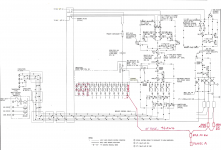electromagnuts
Member
- Location
- USA
- Occupation
- EE
Have a project replacing an old delta-wye unit-substation. There are some loads that need to remain energized during construction so they "temporarily" connected them through a breaker on an adjacent delta-delta unit-sub. Basically connecting 4-wire loads to a 3-wire source inside of a temporary fused disconnect near the secondary switchgear. See attached one-line.
I don't know much about the loads that are connected downstream but I am assuming there is unbalance and therefore a need for a neutral. My concern is with the neutral current path back to the source. If there are phase-to-neutral loads, I am not really sure where the source even exists. Electrical current always flows in a loop. A grounded wye provides a reference for the potential but a neutral conductor is installed to provide an engineered path for the current so that it doesn’t actually flow through the earth, which can be unpredictable and dangerous. Care needs to be taken to make sure that parallel paths aren't created by grounding the neutral at multiple locations. Which begs the question of why a multi-grounded neutral distribution system is a good idea. But I digress...
In this case, the neutral conductor simply stops at the point where they made the transition from 3 to 4 wire. The remainder of the path to the phase-to-neutral/ground source seems ambiguous, and this is where my safety concern arises because the current has to be going somewhere. Maybe it's finding a path to another grounded-wye transformer, on the same primary system, somewhere nearby?
My contention is that transitioning from delta to wye (3 to 4 wire) happens all the time, but it needs to be done in a way that creates a proper phase-to-ground source, such as a grounding transformer and not just in a fused disconnect. But I guess also that if there are no 277V loads downstream, maybe there isn't a problem?
I don't know much about the loads that are connected downstream but I am assuming there is unbalance and therefore a need for a neutral. My concern is with the neutral current path back to the source. If there are phase-to-neutral loads, I am not really sure where the source even exists. Electrical current always flows in a loop. A grounded wye provides a reference for the potential but a neutral conductor is installed to provide an engineered path for the current so that it doesn’t actually flow through the earth, which can be unpredictable and dangerous. Care needs to be taken to make sure that parallel paths aren't created by grounding the neutral at multiple locations. Which begs the question of why a multi-grounded neutral distribution system is a good idea. But I digress...
In this case, the neutral conductor simply stops at the point where they made the transition from 3 to 4 wire. The remainder of the path to the phase-to-neutral/ground source seems ambiguous, and this is where my safety concern arises because the current has to be going somewhere. Maybe it's finding a path to another grounded-wye transformer, on the same primary system, somewhere nearby?
My contention is that transitioning from delta to wye (3 to 4 wire) happens all the time, but it needs to be done in a way that creates a proper phase-to-ground source, such as a grounding transformer and not just in a fused disconnect. But I guess also that if there are no 277V loads downstream, maybe there isn't a problem?

